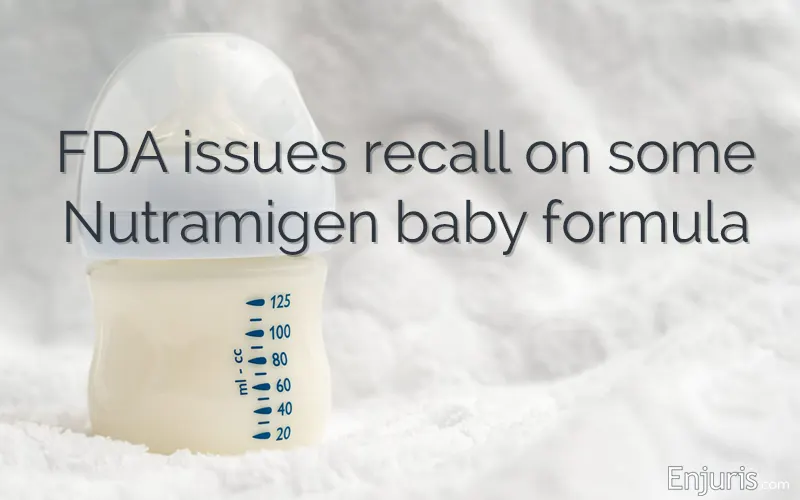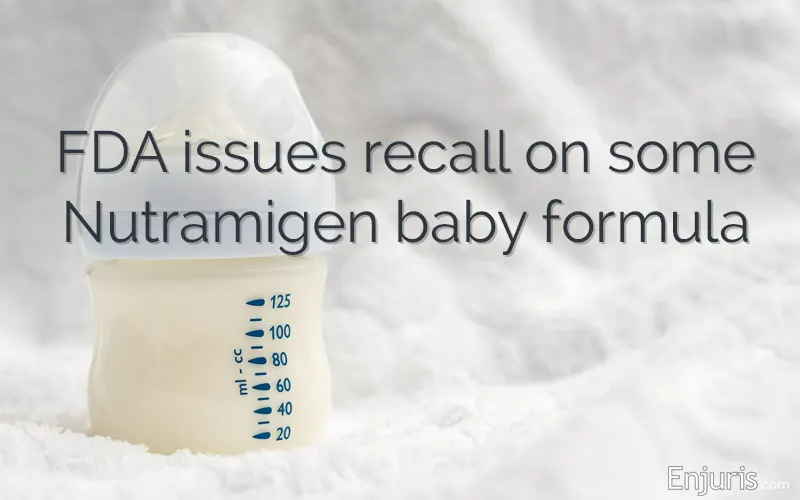[ad_1]

Baby formula recalled for possible Cronobacter contamination
Cronobacter is everywhere, but it won’t affect most people. Babies are an exception. Here’s what you need to know about the most recent recall and best practices for preparing baby formula safely.
Nutramigen baby formula is specially designed for babies allergic to cow’s milk. Parents of babies newly diagnosed with a milk allergy don’t have a lot of options for what their newborns can digest; often, they can’t tolerate breastmilk or traditional formula, so Nutramigen could be one of their only options.
But things just got more complicated.
In early January 2024, the Food and Drug Administration announced a recall on more than 675,000 cans of Reckitt/Mead Johnson Nutrition’s Nutramigen infant formula sold in the U.S.
The recall was issued after authorities confirmed that some cans exported from the U.S. contained Cronobacter sakazakii bacteria. The affected cans were produced at a Mead Johnson plant in Zeeland, Michigan.
It’s important to note that the contamination report was from an international importer; the formula cans tested by the FDA in the U.S. were negative for the bacteria. However, the company recalled all batches produced in the facility around the same time out of an abundance of caution.
There have been no reports of illness related to the recalled product.
However, the recall is a double-edged sword. On one hand, the FDA and the manufacturer want to ensure that every can of baby formula on market shelves is safe. On the other, they’re aware that there’s always limited availability and they don’t want to remove more cans than necessary.
The affected batch codes are:
- ZL3FHG (12.6 oz cans)
- ZL3FMH (12.6 oz cans)
- ZL3FPE (12.6 oz cans)
- ZL3FQD (12.6 oz cans)
- ZL3FRW (19.8 oz cans)
- ZL3FXJ (12.6 oz cans)
They have a UPC Code of 300871239418 or 300871239456 and “Use By Date” of 1 Jan 2025.
What is Cronobacter sakazakii?
Cronobacter sakazakii is a pathogen that exists in nature. It enters manufacturing facilities and even homes from people’s hands, shoes, or another contaminated surface. This bacteria can live in dry food, including herbal tea, powdered milk, starches (like pasta) and powdered infant formula.
Powdered baby formula is not sterile and could become contaminated during the manufacturing process. However, manufacturers and regulators have many checks in place to prevent contaminated formula from reaching store shelves.
Your open can of formula could also become contaminated by Cronobacter in your home.
That’s because Cronobacter bacteria can live on surfaces like kitchen counters and in water. Be cautious about placing formula can lids or scoops on a potentially contaminated surface. Also be sure that the water you mix into the formula and the bottle it’s served in are not contaminated.
How Cronobacter affects babies
A Cronobacter infection could be fatal to a newborn. It could cause a blood infection (sepsis) or swelling around the brain and spinal cord (meningitis).
Some infants are more susceptible than others. They include infants who are:
- Younger than two months;
- Born prematurely; or
- With weakened immune systems.
Symptoms usually include fever, poor feeding, excessive crying, low energy, or seizures.
There are steps you can take to reduce the risk of Cronobacter-related illness affecting your baby. If you’re able to breastfeed, this substantially lowers the risk because there are very few cases of Cronobacter in exclusively breastfed babies. However, some babies can’t tolerate breastmilk, and some parents choose not to breastfeed for a variety of reasons.
Other steps to reduce risk of Cronobacter:
- Properly clean and sanitize feeding items. Adding breastmilk or formula to a partially used bottle or a bottle that wasn’t cleaned correctly could allow germs to grow. Baby bottles, breast pump parts, nipples, caps, rings, valves, and any other object that touches the milk or the baby’s mouth (like teethers or pacifiers) should be cleaned thoroughly and regularly. Take apart bottles and breast pump equipment and clean each part separately to ensure that they’re fully cleaned.
- Wash hands and clean surfaces. Anytime you’re about to prepare a bottle for your baby, the first step is to wash your own hands thoroughly. Use soap and water, and cleanse for at least 20 seconds. Clean the countertop or sink you use during bottle preparation. You should also wash your hands before you touch your baby’s mouth or items that go in their mouth (like pacifiers or toys). And, it’s always best practice to wash after you use the bathroom or change a diaper.
- Prepare and store formula safely. Liquid formula is sterile and should not contain Cronobacter bacteria. Powdered formula is not sterile and could place a baby at higher risk. In addition to being mindful of not placing the scoop or lid on an uncleaned surface, it’s important to close the container as quickly as possible after use. If your baby is at particularly high risk, you might wish to use hot water to further reduce the risk.
It’s often easier to just reach for the hand sanitizer if you don’t have access to soap and water at the moment, but it’s not ideal. Hand sanitizer with 60% alcohol kills Cronobacter but doesn’t kill all germs and doesn’t work well on hands that are greasy or dirty. Washing hands with soap and water is a more thorough and reliable way to ensure they are clean.
If you’re heating water for formula, follow these guidelines:
- Boil water and allow it to cool for five minutes. Mix the formula while the water is still very hot to kill the germs.
- Be sure the bottle or feeding cup you’re using is thoroughly cleaned.
- Use the exact amount of formula as directed on the packaging. Shake to mix the formula and water, rather than using a spoon or other utensil. This reduces the risk of introducing new pathogens into the mixed solution.
- Cool the formula to body temperature before feeding. You can hold a hot, capped bottle under cool tap water but don’t let the tap water get into the bottle or touch the nipple.
- You can test the formula temperature by placing a drop on the inside of your wrist. It should be warm but not hot.
Once you’ve prepared the formula, serve it within one hour from the beginning of feeding and within two hours from the preparation time. If your baby doesn’t finish the bottle, throw out the remaining formula. Your baby’s own saliva can contaminate the formula and cause bacteria to grow.
If you’re preparing formula to use later, refrigerate it immediately. Use it within 24 hours; don’t prepare formula more than 24 hours in advance of a feeding.
What to do if you have recalled formula
If you have formula subject to the Cronobacter recall, you may either return it to the place of purchase or contact the manufacturer at 866-534-9986 or [email protected]. If your baby consumed formula from one of the affected batches, you can call your pediatrician for more information.
[ad_2]



